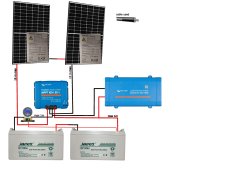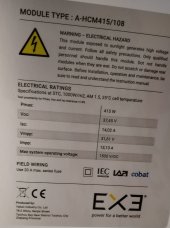Cosmin Rusu
New Member
Hello to you all, I have read all your posts here and I am very interested in this subject. Considering that I want to install an off grid system for running a 4 cctv system and a small refrigerator, I kindly ask you for your help because is the first time for me and I am also a noob in this domain. So here is what I have drawn by myself using the software mentioned above and using what equipment I already bought.
Because of my knowledge in this field (somewhere bellow 0), obviously I have some questions that I need to ask you ofcourse, if you are kind to answer and not to laugh if they are stupid! So here I go:
1. Can I use the same cable for all my connections, including between those 2 batteries? The type of cable is in picture, 4mm solar.
2. Do I need a battery balancer or is ok without it?
3. Fuses are a must in this system?
4. A circuit breaker is needed?
5. Where should I install a dc-dc converter for 12v appliances?
6. Does my system supports 4 solar panels if I connect them in a different way? (this question is because i actually have 3 pcs but for now one is spare!)
Here are also the links for my equipments:
https://www.schrack.ro/comenzi/foto...c-9busbars-5400-pascal-single-pvm44150-s.html
https://www.emag.ro/acumulator-sola...4Tj3Qj07gc3mRfdvQgcXo-FnBEwHd7XAaAjQJEALw_wcB
https://www.electriccasa.ro/regulat...pt-smartsolar-100vdc-12-24vdc-50a-pvbc10050s/
https://www.materialeelectrice.ro/bmv700-kit-de-conectare-monitorizare-de-precizie-baterie-s-83274
https://www.schrack.ro/comenzi/phoenix-inverter-24-800-ve-direct-pvbi24800.html
https://www.schrack.ro/comenzi/cuplor-cablu-tata-4-6mm2-pt-diametru-oe-5-5-9mm-pva12000.html
https://www.schrack.ro/comenzi/cuplor-cablu-mama-4-6mm2-pt-diametru-oe-5-5-9mm-pva11000.html
https://www.schrack.ro/comenzi/foto...hite-singlecore-en-cpr-betaflam-pvw10041.html
https://www.schrack.ro/comenzi/foto...-red-singlecore-en-cpr-betaflam-pvw10042.html
Thank you in advance for your answers and sorry for my english.
Because of my knowledge in this field (somewhere bellow 0), obviously I have some questions that I need to ask you ofcourse, if you are kind to answer and not to laugh if they are stupid! So here I go:
1. Can I use the same cable for all my connections, including between those 2 batteries? The type of cable is in picture, 4mm solar.
2. Do I need a battery balancer or is ok without it?
3. Fuses are a must in this system?
4. A circuit breaker is needed?
5. Where should I install a dc-dc converter for 12v appliances?
6. Does my system supports 4 solar panels if I connect them in a different way? (this question is because i actually have 3 pcs but for now one is spare!)
Here are also the links for my equipments:
https://www.schrack.ro/comenzi/foto...c-9busbars-5400-pascal-single-pvm44150-s.html
https://www.emag.ro/acumulator-sola...4Tj3Qj07gc3mRfdvQgcXo-FnBEwHd7XAaAjQJEALw_wcB
https://www.electriccasa.ro/regulat...pt-smartsolar-100vdc-12-24vdc-50a-pvbc10050s/
https://www.materialeelectrice.ro/bmv700-kit-de-conectare-monitorizare-de-precizie-baterie-s-83274
https://www.schrack.ro/comenzi/phoenix-inverter-24-800-ve-direct-pvbi24800.html
https://www.schrack.ro/comenzi/cuplor-cablu-tata-4-6mm2-pt-diametru-oe-5-5-9mm-pva12000.html
https://www.schrack.ro/comenzi/cuplor-cablu-mama-4-6mm2-pt-diametru-oe-5-5-9mm-pva11000.html
https://www.schrack.ro/comenzi/foto...hite-singlecore-en-cpr-betaflam-pvw10041.html
https://www.schrack.ro/comenzi/foto...-red-singlecore-en-cpr-betaflam-pvw10042.html
Thank you in advance for your answers and sorry for my english.




